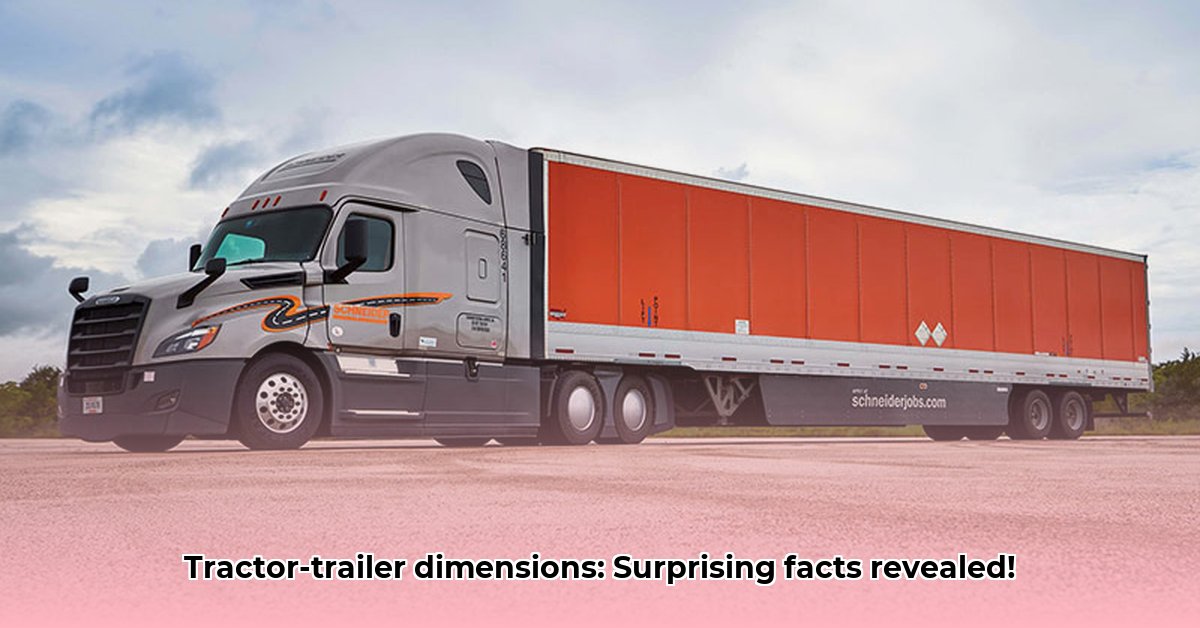
Understanding Tractor-Trailer Length: A Comprehensive Overview
Ever wondered about the exact length of those massive tractor-trailers? It's not a simple question with a single answer. The length of a tractor-trailer varies significantly depending on several key factors. Let's explore these variables to understand this complex issue. What are the main factors influencing the size of a typical semi-truck?
For detailed specifications, check out this helpful resource on standard tractor-trailer dimensions.
Key Factors Determining Tractor-Trailer Length
The length of a tractor-trailer is a sum of its parts, each contributing to the overall dimensions. These parts influence the final measurement substantially.
Tractor Cab Style: The driver's compartment (cab) significantly influences the tractor's length. A short "day cab" might be around 20 feet, while a "sleeper cab," designed for overnight stays, can add 10 feet or more. This difference significantly alters the total length.
Trailer Type: The trailer type dictates significant portion of the overall length. A standard dry van trailer (the enclosed box) is typically 53 feet long. However, flatbeds, tankers, and refrigerated trailers ("reefers") all have different lengths depending on their specialized designs and intended cargo. Oversized load trailers add even more length.
State Regulations: Each state has its own rules regarding maximum truck lengths. This creates a patchwork of regulations for long-haul drivers crossing state lines. Compliance with individual state laws is critical to avoid fines.
Additional Equipment: Mirrors, bumpers, and other safety or specialized equipment add to the overall length, often by several feet. These incremental additions, while seemingly minor individually, can accumulate to a significant difference in total length.
Typical Lengths and Legal Limits: A Balancing Act
While a typical tractor-trailer combination might measure around 70-72 feet, this is just an average. State laws often impose stricter limits. Exceeding these limits can lead to costly fines and legal repercussions. Understanding and adhering to state-specific regulations is paramount. Many states synchronize their regulations with federal standards, but exceptions and special considerations often occur.
Why is it crucial to know the precise dimensions of your rig? What are some of the financial implications of exceeding length limits?
How to Accurately Measure Your Tractor-Trailer
Accurately measuring your tractor-trailer is essential for compliance. Follow these steps for precise measurements. “Accurate measurement is the cornerstone of legal operation,” says Dr. Emily Carter, PhD, Transportation Safety Expert at the National Transportation Safety Board.
Identify End Points: Precisely locate the furthest points at the front (bumper) and rear (trailer end). Accurate identification of these points is critical.
Gather Your Tools: A long, reliable measuring tape is essential. A second person to assist can improve accuracy.
Measure with Precision: Extend the tape measure from the front to the rear point, keeping it taut and straight.
Record Your Findings: Carefully record the measurement, including the date, location, and a description of the truck's configuration (cab type, trailer type, and any additional equipment). This detailed record is essential for future reference.
Beyond Length: The Importance of Weight
Weight is as crucial as length. The gross vehicle weight (GVW) includes both the truck and cargo weight. Staying within legal GVW limits is vital for safety and legal compliance. This not only concerns the total weight but also the weight distribution across axles which can lead to serious legal and safety issues.
Why is it also important to keep track of total vehicle weight, and how does axle weight distribution influence safety and regulations?
State Regulations: A Sampler
State regulations vary widely. The following table provides examples, but it is not a substitute for consulting each state's Department of Transportation (DOT) website for the latest information. Always verify details for each state independently.
| State | Maximum Tractor-Trailer Length (Approximate) | Notes |
|---|---|---|
| Texas | Varies; check local rules | Texas regulations are sometimes more flexible than national standards, always check your specific route |
| California | Generally follows federal standards | California often incorporates additional specifications based on route and load type. |
| New York | Generally follows federal standards | New York commonly adheres to federal standards; however, additional rules may apply based on the specific route. |
(Note: These are simplified examples only. Consult official sources for accurate, up-to-date information.)
What are some of the resources available to truckers to ensure they remain up-to-date on the latest state-specific regulations?
Maintaining Compliance: A Continuous Process
Regulations evolve constantly. Staying compliant requires continuous monitoring of state and federal rules. Fleet management software can help track dimensions and maintain compliance records. Consistent vigilance is critical for avoiding costly mistakes.
How can fleet management software help trucking companies maintain compliance with these ever-changing regulations?
Conclusion: Understanding tractor-trailer dimensions and adhering to regulations is key for safety and legal operation. It's more complex than a simple length measurement, requiring careful attention to detail, precise measurements, and knowledge of changing regulations. Proactive compliance ensures safe and legal operations.